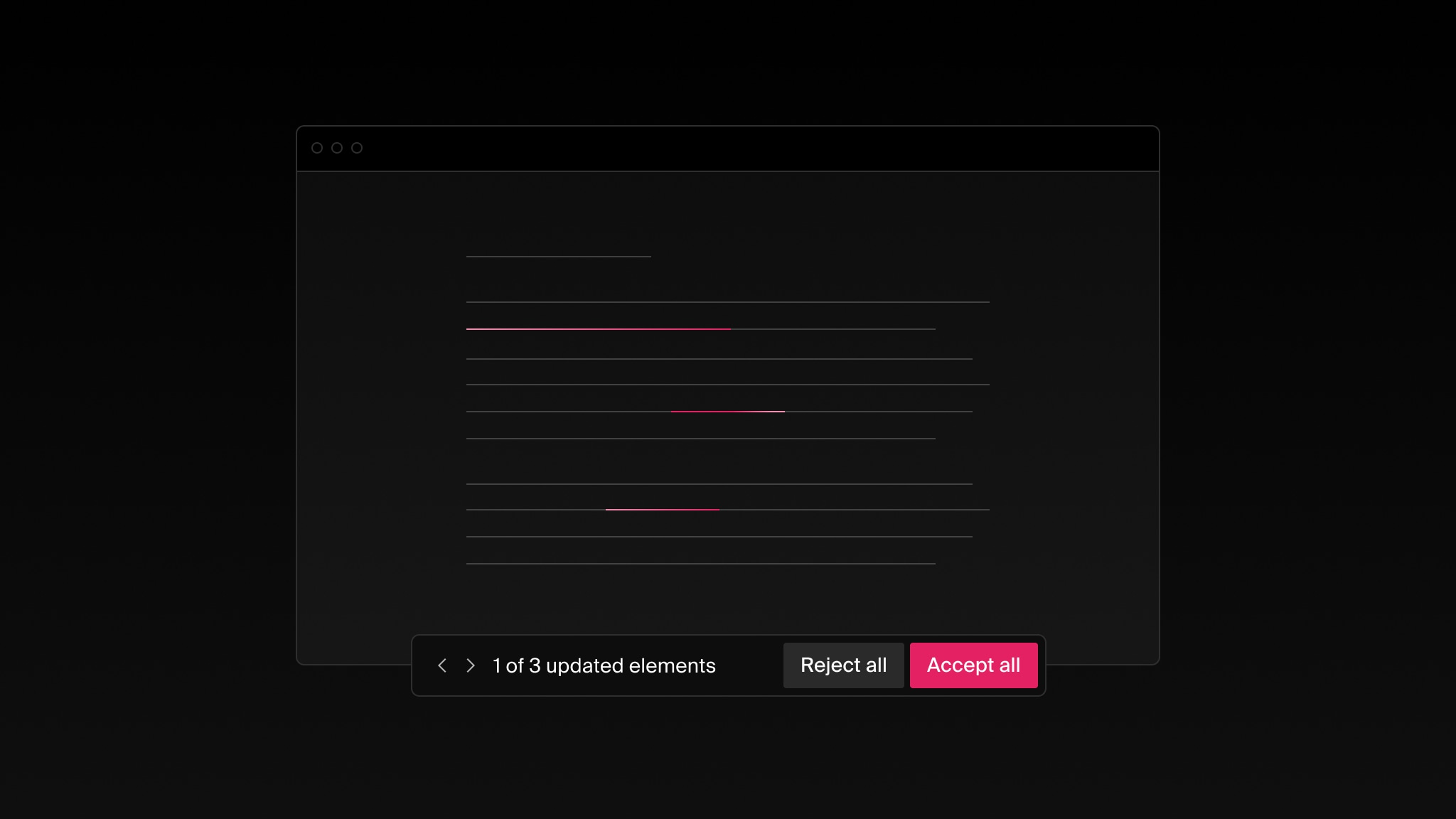Building an AI copilot inside your Tiptap text editor
How to add advanced AI editing to your Tiptap text editor with tool calls, realtime streaming, and diffs

When most SaaS teams talk about adding AI to their product, they think of a sidebar assistant that drafts text or a modal that pastes content into the editor. But a true AI copilot doesn’t live outside the editor—it lives within it. It understands the document, its structure, the user’s intent and can edit, reorganize, and reason over complex content.
That’s what we built when working with our client, Distribute, a go-to-market platform with a collaborative document editor. Here’s what we learned while turning a traditional editor into an AI-native workspace.
The editor
Distribute’s text editor uses a structured, schema-based document system that supports custom layouts, tabbed sections, and user mentions. To make AI truly useful in that context, we needed more than a content generator. The copilot had to:
- Understand the entire document structure (not just current selection)
- Modify any part of it, from rewriting a paragraph to merging two tabs
- Preserve strict schema validity and contextual placeholders
- Respect the collaboration model — users must see, review, and accept changes safely
The result: a copilot that feels native to the editor, not bolted on top.

The editor with diffs, and AI chat with diffs, accept/reject dialog
Key technical challenges
Working with a strict document model
Distribute’s editor runs on Tiptap, built over ProseMirror, meaning every node and mark is validated against a schema. That’s great for consistency but hard for AI, since large language models are much more comfortable producing text than tree structures.
Our first idea was to ask the LLM to generate a stream of edit operations referencing node IDs. In practice, this proved unstable—the model could easily lose track of structure, break references, or output malformed operations.
So we inverted the problem. Instead of operations, the model outputs a complete edited document, but written in a restricted JSX-style markup that mirrors our schema. Alongside it, the model includes a short meta-comment explaining what it changed and why.
We then diff this version against the user’s original document to extract precise edits.
We realized that LLMs are great at rewriting but terrible at patching. Once we gave it a strict language and compared outputs ourselves, everything clicked.Myron MavkoFounder at Flexum
This design gave us reliability without sacrificing flexibility.
Extended-text diffing
Diffing two structured documents is hard. Naive character/word diffs ignore node boundaries and semantics; purely tree-based diffs often treat intra‑node text edits as whole‑node replacements, obscuring the minimal change set. We needed both views at once. We built a hybrid method we call extended-text diffing.
The idea is to flatten the document into a text-like sequence but preserve structure as metadata. We convert every visible and invisible element into a token—even visual blocks like images or dividers get symbolic representations. Each token carries metadata about its original formatting and position in the tree.
This lets us:
- Run a classic text-diff algorithm (LCS-style) on the flattened form.
- Reconstruct a structured document with semantic awareness.
- Label every node as unchanged, added, updated, or removed.
The outcome is a perfect balance: simple diff logic, yet structure-aware precision.

Extended-text diffing
Streaming responses in realtime
Waiting for the full model response before showing anything would make the experience feel sluggish. Instead, we stream tokens as they arrive and immediately generate diffs on that partial content so the user can watch the copilot’s work unfold in realtime.
The challenge is that a streamed document is incomplete, so the temporary tail of the diff may falsely appear to be removed text simply because those tokens haven’t arrived yet. To keep the experience consistent, we hide that trailing removal fragment until streaming completes, revealing the full text once the model finishes.
This way, users see responsive, continuously updating feedback with accurate diffs from the first second to the last.

Our AI App Builder example demos this—the trailing code is kept visible until the stream completes.
Collaboration and privacy
In a shared document, AI should never surprise teammates. Our rule: preview locally, publish deliberately.
Here’s the workflow:
- When a user invokes the copilot, their editor switches to a read‑only diff view of the proposed changes.
- Other collaborators continue editing as usual; their updates keep syncing and are immediately reflected in the user’s diff view.
- The user can review, chat, and iterate as needed. Accept applies the change set and publishes it to everyone as that user’s edits; Reject discards it.
This keeps the session private without pausing collaboration or forking state. The implementation is a custom diff renderer inside the editor—no paid editor plugins, no special server mode. It works with any strict‑schema editor and any real‑time layer (e.g., Liveblocks) because it’s just view state plus deterministic apply/revert.
This handles the diff preview outside of the AI chat, but we need to build the AI chat itself, with its own accept/reject dialog.
Building an advanced AI chat
Most AI chat libraries are built on HTTP streaming, which is prone to breaking due to network issues, timeouts, and other factors. Additionally, it’s difficult to handle front-end tool calls, confirmation flows, and realtime feedback with HTTP streaming, which is why we recommend using WebSockets instead of HTTP for AI chats.
The ready-made Liveblocks
AiChat component handles all
this, rendering a realtime chat interface, and you can add the current document
state to the chat as
knowledge,
so it understands the starting point before it makes changes.
Alongside this you need a human-in-the-loop tool that allows AI to edit and stream in the changes in realtime, with a confirmation flow, so that the user can accept or reject the changes.
Results
The editor now supports full-document understanding and structural manipulation through AI, enabling copilot suggestions that can modify entire layouts while keeping schema validity intact. Users can review changes inline, accept them safely, and continue collaborating instantly as AI responses stream in real time, creating a seamless, engaging authoring experience.
Lessons learned
- LLMs prefer rewriting, not patching. Let them produce a clean new version and control structure externally.
- Schema safety comes first. A strict markup contract keeps your data valid and predictable.
- Diffing is where magic happens. Our extended-text diffing bridged language and structure elegantly.
- Streaming adds life without lag. Show diffs as tokens arrive; suppress only the trailing‑removal artifact until the stream completes.
- Collaboration needs isolation. Private layers preserve UX trust without breaking realtime sync.
- WebSockets instead of HTTP. WebSockets reliably enable more advanced features like tool calls, confirmation flows, and realtime feedback.
Takeaways for builders
Embedding AI in structured, collaborative editors isn’t about prompt crafting, it’s about architecture. Once you own your schema, diffing, and collaboration layer, AI can operate natively within your product.
Whether you stream your own model output or use Liveblocks’ ready-made
AiChat component for
collaborative streaming, the principle is the same—responsiveness, control, and
trust.
At Flexum, we build structured, intelligent editing experiences for modern SaaS products. The Distribute copilot is one example of how engineering precision can turn AI from a novelty into a first-class collaborator.
Ready to get started?
Join thousands of companies using Liveblocks ready‑made collaborative features to drive growth in their products.


